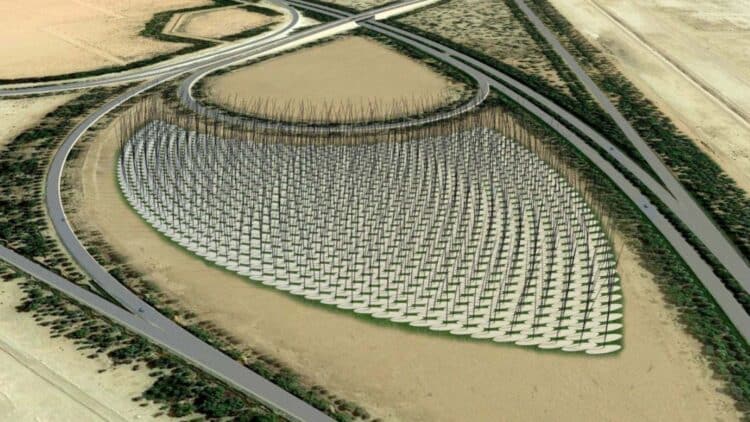Over 1,200 shining towers in an Arab desert are reimagining how we think about wind power with the Windstalk project, not just being a power plant, but a forest of towers, or rather a kinetic sculpture that beckons tourists while showcasing advancement in terms of sustainable energy. While this Arabian desert is known for oil, it is being globally recognized for the sea of carbon-fiber poles that are silently leading to changes in renewable power.
Tapping into wind energy, but not with wind farms
The Windstalk project is a wind farm, but not in the traditional sense. It consists of 1203 fiber resin poles that slice through the air, eliminating all of the problems associated with wind farms. The entire Windstalk concept was designed by New York design firm Atelier DNA, which considered all of the complaints related to traditional wind farms and chose the route of a wind farm without any blades or rotating machinery.
The Windstalk array of poles comprises 55-meter-tall carbon-fiber poles that flex and bend, similar to reeds when there is a breeze. Within these flexible stalks are piezoelectric ceramic discs and electrodes. With the pole swaying in the wind, the disc compresses and produces electricity through the piezoelectric effect, where mechanical strain is converted into electrical current.
When this happens, poles glow with LED lights. The brightness or dimness of the LED lights is determined based on the energy production, causing the entire array to look like a gamut of radiant light. When there’s barely any wind, the lights fade to indicate this.
Looking at kinetic energy and storage
The Windstalk system looks at energy generation through swinging poles that are based on the torque generator, harvesting additional energy by provoking fluid through the current-generating shock absorbers when the pole moves.
Atelied DNA proposed a solution for energy storage that exceeded that of other energy storage methods. Underground chambers that somehow look like inverted pole bases perform the function of a gravity battery. Any excess electricity pumps water to a higher chamber. When the wind speed is much lower, water flows down and encourages the turbines to continue turning and generating electricity. Power is steady, and the bases of these structures have a phyllotactic pattern which resembles that of sunflowers. Energy creation is ensured while still enabling visitors to walk through the display easily.
The true beauty behind the Windstalk project
The Windstalk project is a beautiful tourist wonder, but the true beauty of Windstalk is that it provides answers to the global environmental problem, addressing issues previously associated with wind turbine structures, and as such:
- Causes no bird deaths due to having no rotating blades.
- Does not lead to noise pollution and is a suitable solution in residential areas.
- Increases the energy output per square meter due to denser spacing.
- Plant growth is ensured due to water harvesting from the less frequent desert rain.
Windstalk in all its glory does provoke us to reassess how we improve the sustainable energy game by changing conventional thinking and by providing a solution that’s quieter and more visually pleasing. Dubai is focusing on clean energy by turning on Earth’s most powerful generator.
A design field for the future of the UAE and beyond
The Windstalk project is one that captures the vision of the UAE to offer more than oil. The concept created by the New York design firm stands tall in Masdar City, Abu Dhabi. With no blades and no noise, this surely is a lucrative solution that simultaneously transforms an installation into a public space. When art and energy collide, the results can still be energy generation in the most stunning way. The Atelier DNA windstalk concept gained the second prize in the Land Art Generator Initiative (LAGI) competition in 2010 as well. One thing is clear: this strange wind farm turns into a spectacle every night.
Disclaimer: Our coverage of events affecting companies is purely informative and descriptive. Under no circumstances does it seek to promote an opinion or create a trend, nor can it be taken as investment advice or a recommendation of any kind.


